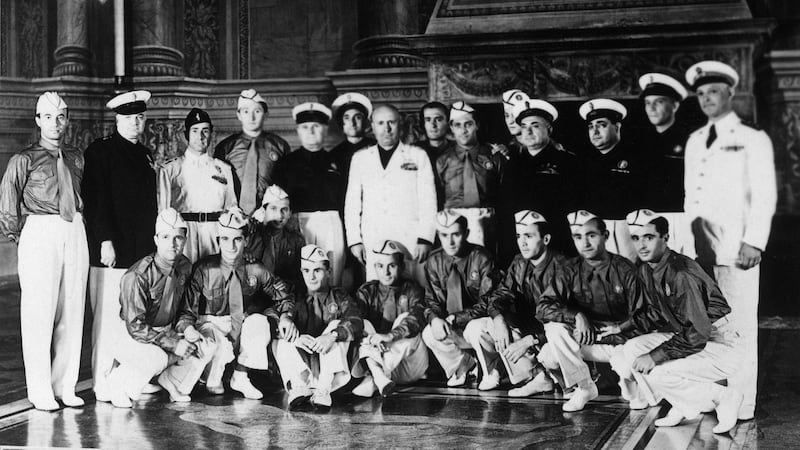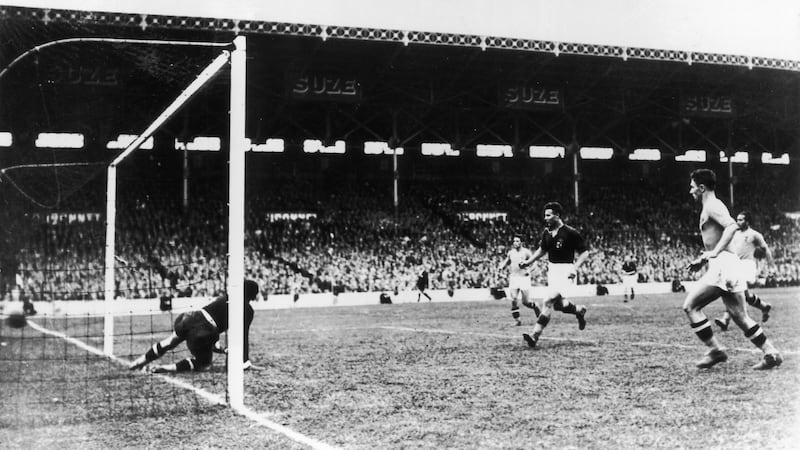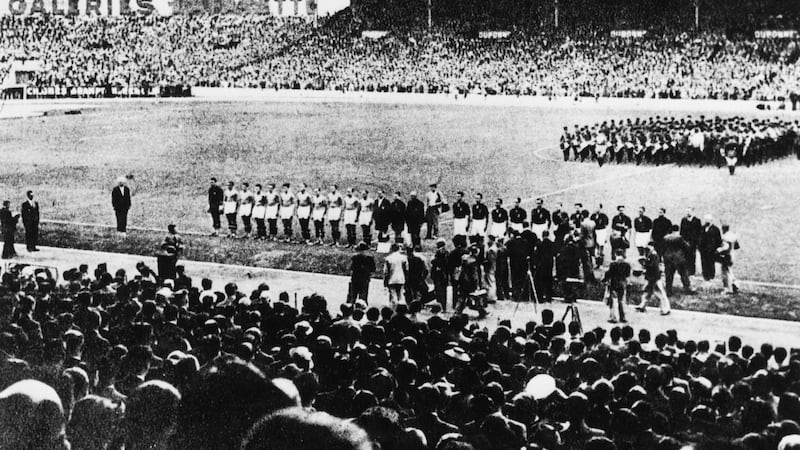The critical moment was … when our players raised their hands to give the fascist salute … I entered the stadium with our players, lined-up military style, and stood on the right. At the salute we predictably met with a solemn and deafening barrage of whistles, insults and remarks. It seemed like we were in Italy so much did the expressions resound of our idioms and dialects. How long that rumpus lasted I couldn’t say. I was rigid, with an arm outstretched horizontally I couldn’t check the time. The German referee and Norwegian players looked at us worriedly. At a certain point the hullabaloo began to die down and then ceased … We had just put our hands down and the violent demonstration started again. Straight away: “Team be ready. Salute.” And we raised our hands again, to confirm we had no fear … Having won the battle of intimidation, we played.
The recollection of Italy’s 1938 World Cup first-round match with Norway by the national team coach Vittorio Pozzo encapsulated fascism’s single-minded, uncompromising approach to retaining the trophy it had won at home four years earlier.
Aware of the game’s cross-national appeal and powers of propaganda, the fascist regime invested hugely into rationalising and regenerating the Italian game. Slow to industrialise, Italy was a latecomer to football with the game’s boom coming either side of the first world war. Winning the war but losing the peace brought widespread disaffection which, combined with the threat of communism, fuelled the rapid rise to power of Mussolini and the fascist regime.
Having established dictatorship Il Duce turned his attention to trying to mobilise the nation behind the regime. Sport was fundamental in this and despite his initial lack of enthusiasm and unquestionable deficit in talent, football, or calcio as fascism’s linguistic nationalism demanded, became its keystone. The 1926 Viareggio Charter turned calcio into a fascist game. Led by the head of Bolognese Fascism Leandro Arpinati, the Federation set about revolutionising the game. Most notable was the formation of a national league, Serie A. The intent was twofold: firstly, to forge a sense of national identity and, secondly, to create a stronger, more competitive structure that would result in a national team capable of rivalling the best.
The fruits of the investment began to emerge in the early 1930s as Italian club teams challenged those of central Europe and Britain for supremacy. The generation bloomed in 1934 as Italy hosted and won the World Cup. But there were two nagging doubts that undermined Italian claims to supremacy: the absence of the English team and the rumours of corruption and the buying of referees. There is little concrete evidence to support the latter, but England remained a thorn in calcio’s side with Italy unable to secure a victory in three highly-charged matches in the 1930s.
While England remained in isolation, France 1938 was an opportunity for Italy to retain the trophy in a foreign land and scotch those rumours. But by the time the tournament came around there was good reason to dislike what many in France, in particular, were coming to realise was a particularly nasty regime.
Carlo Rosselli, one of Europe’s most charismatic and influential anti-fascist intellectuals who had been living since 1929 in exile in France, was rumoured to have schemed a variety of plots to assassinate Mussolini. His support for the expansion of the Spanish Civil War into a European anti-fascist war made him one of the regime’s most dangerous enemies and placed him high on its wanted list. Along with his brother Nello, a noted historian, he was killed on a country road in Normandy, on June 9th 1937. Both were stabbed, Nello finished off with a pistol. As many as 200,000 people are said to have attended their funerals in Paris.
While the Italian press tried to link their assassinations with anti-fascist communists and anarchists, the responsibility actually rested with a secret French extreme right-wing group, Cagoule, which had connections to the French secret services. While there was no smoking gun directly connected to Mussolini, the Italian secret police had been watching Carlo Rosselli in his hotel. Two days after their assassination Leon Blum submitted his resignation as prime minister of the anti-fascist Popular Front coalition.

Franco-Italian relations weren’t helped by Mussolini’s anti-French/pro-Franco statements on May 14th 1938. Declaring his support for General Franco in the Spanish Civil War, his contemporaneous announcement of a political accord with England threatened the encirclement of France. This was the political context to the Italian’s team’s arrival in 1938, where anti-fascist protests became that tournament’s Mexican wave. Arriving with the squad in Marseille, where there was a significant presence of exiled Italians, Ugo Locatelli later recalled some 3,000 or more French and Italian protestors being controlled by baton-wielding mounted police. His account contrasted with the Italian press’ record of a courteous reception at the station by a number of dignitaries and over-enthusiasm from local and Italian supporters.
In 2001 I interviewed Piero Rava, the only surviving member of that team. He was unable to remember the alleged protest. Whether his memory had been reduced by the years or was deliberately selective I was never able to ascertain, but given such incidents continued throughout the competition Locatelli’s recollections still seemed on the money. Less doubt surrounds the intended recipient of the protests: the team. As the representative of the regime rather than the nation, it reaped what Fascism had sowed 12 years earlier with its politicisation of football.
Understandably unpopular, the Italian team’s warm ‘welcome’ wasn’t the sort of thing to trouble Vittorio Pozzo, journalist and unpaid Supreme Commander or Commissario Unico of the national team, who instilled a strong sense of militarism into his and Mussolini’s boys. Settling potentially divisive inter-club rivalries by forcing antagonistic players to room together, the ambience of his training camps was more akin to the armed forces. Closely connected to the fascist hierarchy, Pozzo incarcerated his squad in ritiro (retreat) and marches through the woods became the order of the day. His motivational tactics were often decidedly nationalistic, with an away trip to Hungary in 1930 including a detour to the monumental first world war cemetery of Redipuglia where, among the war dead, the players were reminded of their responsibilities and the sacrifices of their forefathers.
The Azzurri’s opening match in Marseille saw them up against Norway on the field and an estimated 10,000 Italian political exiles in the terraces, even if the Corriere della Sera’s journalist Emilio De Martino claimed the crowd’s strong Scandinavian leanings was more a reflection of its pleasure at its earlier unexpected elimination of Germany. Pozzo, however, recalled:
… a background of political-polemic. Unjustly. Because our players never even dreamed of making it something political. They represented their country and they naturally wore its colours and symbol.
The problem was, this symbol was the Fascio Littorio, a bundle of sticks and an axe. Carried by the Romans as a sign of law and order, it had been appropriated by the fascist regime for similar reasons. Fascism’s anthem Giovinezza (Youth), also played as the team entered the stadium, but it was Italy’s Roman salute that most angered the crowd, especially when Pozzo ordered its repetition.

The under-pressure Azzurri were less than impressive in snatching a 2-1 victory in extra-time. “Vittoria ma non basta” (Victory but not enough) summed up the press’ general disappointment. The fascist militia general and football federation head Giorgio Vaccaro was also unhappy with the presence in defence of the ageing Eraldo Monzeglio instead of Alfredo Foni. Pozzo claimed pressure from Villa Torlonia, Mussolini’s Roman residence where Monzeglio was often to be found coaching football and playing tennis with Il Duce and his sons. Vaccaro’s intervention ended Monzeglio’s international career and illustrated the political interference in team selection that Pozzo claimed had forced him to pick only players that were party members in 1934.
The tremors from Marseille were felt in Paris, where Italy met France in the quarter-final. If the anti-fascist protests had shaken the Azzurri’s confidence in Marseille, from the “theatre of hostility” that was the Colombes stadium the team drew inspiration. In his detailed account of the Italy’s two World Cup wins and Olympic football gold medal in 1936, Pozzo glossed over this match, just as the regime liked to do with all unpleasant news.
With both countries normally playing in blue, lots were drawn to decide who should change. Italy lost and rather than wear its traditional change colour of white, the team was ordered to play in all-black. Still smarting from the poor reception in Marseille, the decision is often cited as having emanated directly from Mussolini. While the maglia nera (black shirt) had been worn by Italy’s victorious team of students in Berlin this was the only time it ever appeared in a full international. Displaying a far from subtle Fascio Littorio on the left breast, it was a direct representation of the regime and an unmistakable two fingers to all anti-fascist protestors.
The “manifestly hostile” crowd was silenced by a comfortable 3-1 Italian win. As the fascist daily Il Popolo d’Italia recorded, the squad pulled out its best performance of the tournament: “It is Italy – the blue shirt with the Savoy shield and the Fascio Littorio on its chest – that has won the right to contest the final in Paris.”
The importance of victory for the fascist regime was obvious. But beyond the Darwinistic kudos that associated the achievement with Fascism’s apparent regeneration of the Italian race, there were those rumours of corruption during the 1934 tournament that needed scotching. Such was its desperation, a legend-cum-urban-myth developed regarding a telegram apparently sent to the team by Mussolini, prior to the final, with the simple instruction: “Win or Die”. Not surprisingly it wasn’t archived among government foreign despatches and neither did Rava give it credence when I met him. “No, no, no, that’s not true. He sent a telegram wishing us well, but no never ‘win or die’.” Sometimes truth gets in the way of good story.

With the final against Hungary tied at 1-1, Italy showed their class with 20 minutes of widely acclaimed football in which they scored two goals, secured the title and apparently won over the crowd. “In those 20 minutes of spectacular play they forgot their political and ethnic prejudices,” said Rava. I wonder?
The game ended 4-2. For their efforts each squad member was rewarded with an 8,000 Lire win bonus (about three months’ salary) and a fascist Gold Medal, which was presented by Mussolini during a 15-minute reception with the team in the Palazzo Venezia in Rome. Interestingly enough, given his megalomania and enthusiasm for global domination, Italy’s “No1 sportsman” never raised the trophy himself.
Fascism already had its eyes on a third consecutive trophy in 1942, but the outbreak of the second world war put paid to that. After the regime fell in 1943 and Italy was liberated 18 months later, Pozzo made the seamless transition from the dictatorship to democratic Republic. He remained Italian coach until 1948 and carried on writing for La Stampa up until his death 20 years later.
But for all of Italy’s unquestionable talent and unprecedented success, the political gestures of a black shirt and a double-Roman salute that encapsulated Italian football’s rise under fascism were extraordinary, especially in the context of France at the time and what was to come. Fascism may have won the battle of intimidation on the field, as Pozzo had said, but it would soon lose the war and the black shirt and Roman salute be consigned to one of the World Cup’s and Fifa’s least edifying but overtly political moments.
• Sport Italia by Simon Martin, published in 2011 by IB Tauris, narrates the history of modern Italy through the national passion of sport
(Guardian service)













